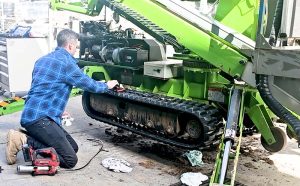Maintaining agricultural and construction equipment is essential to ensure efficient operations and prolong the lifespan of these valuable assets. Among the crucial components of heavy machinery like excavators, tracks play a pivotal role in providing stability, traction, and manoeuvrability. Proper maintenance of excavator tracks can save time, money, and prevent downtime. In this blog, we’ll explore some valuable tips and tricks to help you keep your excavator tracks in tip top condition.
1. Regular Inspection
Just like any machinery, a routine inspection of your excavator tracks is paramount. Regularly check for signs of wear, damage, or misalignment. Look for cracks, missing components, or bent links. Identifying these issues early can prevent further damage and costly repairs.
2. Cleaning and Adjustment
Excavators often work in harsh environments, encountering mud, dirt, and debris. Regularly cleaning your tracks helps prevent buildup that can accelerate wear and tear. Adjusting the tracks according to the application can help avoid the tracks over tensioning due to build-up of mud, dirt or debris in the tracks. For example if operating in heavy mud and or sand, it is advisable to reduce the track tension before working in such an environment.
3. Proper Operation
Operator behaviour plays a crucial role in the lifespan of excavator tracks. Avoid excessive spinning or sudden direction changes, as these actions can cause unnecessary stress on the tracks. Train your operators to operate the equipment smoothly and efficiently to minimise wear, this is called track turning compared to the more rigorous skid turning.
4. Track Tension
Maintaining the correct track tension is vital for preventing premature wear. Tracks that are too loose can lead to excessive wear on the sprockets and idlers, while tracks that are too tight can cause stress and damage to the undercarriage components. Follow the manufacturer’s guidelines for proper track tension adjustment.
5. Track Alignment
Misaligned tracks can lead to uneven wear and reduce the overall stability of the excavator. Regularly check and adjust the track alignment to ensure that both tracks are parallel and evenly spaced.
6. Replacement Strategy
At some point, even with diligent maintenance, excavator tracks will need to be replaced. Having a well-defined replacement strategy based on factors like hours of operation, wear patterns, and operational conditions can help you avoid unexpected downtime and improve overall efficiency.
7. Keep Records
Maintain comprehensive records of your excavator’s maintenance history. This includes details of inspections, maintenance tasks performed, replacement dates, and any repairs. These records can provide valuable insights into the health of your equipment and help you plan maintenance schedules effectively.
8. Collaborate with Experts
If you’re unsure about certain maintenance tasks or which type of tracks are best for your excavator, don’t hesitate to consult with experts or the equipment manufacturer. At TKV our friendly team is here to help with all your track and undercarriage needs, get in touch today for expert advice!
Excavator tracks are integral components of agricultural and construction equipment, and their proper maintenance is crucial for optimal performance and longevity. By following these tips and tricks, you can significantly extend the life of your excavator tracks, reduce downtime, and improve overall operational efficiency. Remember that a well-maintained excavator not only saves you money but also enhances safety and productivity on the job site.


